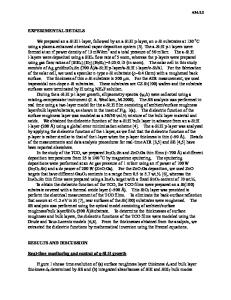Ftir Spectroscopy and Spectroscopic Ellipsometry Study of Nanocrystalline Layers Formed by High-Dose Hydrogen and Deuter
- PDF / 1,535,134 Bytes
- 6 Pages / 612 x 792 pts (letter) Page_size
- 33 Downloads / 340 Views
FTIR SPECTROSCOPY AND SPECTROSCOPIC ELLIPSOMETRY STUDY OF NANOCRYSTALLINE LAYERS FORMED BY HIGH-DOSE HYDROGEN AND DEUTERIUM IMPLANTATION OF SILICON L.N. Safronov, E.V.Spesivtsev, V.P.Popov, I.V.Antonova, A.K.Gutakovskii, V.I.Obodnikov Institute of Semiconductor Physics, RAS, 630090, Lavrentieva 13, Novosibirsk, Russia, A.P. Stepovik, V.T. Gromov Federal Nuclear Center, Snezhinsk, Russia ABSTRACT Structural study of a-Si layers formed by high fluence hydrogen or deuterium implantation (up to 5x1017 cm-2) using high current beams with means of current up to 40 mA/cm2 was carried out in the present work. The Si:H(D) silicon films were characterized using FTIR spectroscopy, spectroscopic ellipsometry, transmission electron microscopy and secondary ion mass spectrometry. Hydrogen solubility in crystalline silicon is low but ion implantation allows one to introduce hydrogen atoms in the concentration of 1022cm-3 or even more in thin silicon layer. High defect concentration in combination with high hydrogen activity causes the formation of mixed amorphous and crystalline phases with structure similar to silicon produced by PECVD or laser ablation. The transformation of optical properties of this film during annealing in temperature range of 200-1050oC was investigated. The changes in optical characteristics and number of Si-H or Si-D bonds in the spectra of IR absorption is correlated with increase in crystalline volume of silicon with a temperature. INTRODUCTION Silicon based materials, that contain Si nanocrystals, attract an interest of researchers following unique optical and electronic properties such as nonlinear optical properties, electro- and photoluminosity, wider forbidden gap [1-3]. They can obtain by PECVD of silane [4] or laser ablation [1]. Solid solubility of hydrogen CH is very low in single crystalline silicon CH(m-Si) ~1016cm-3, and it is much higher in amorphous silicon (a-Si) CH(m-Si) ~ 5x1021cm-3 [5]. If CH is higher than these values abundant hydrogen can form clusters and voids filled with molecular hydrogen. Ion implantation allows one to introduce such high concentrations. The aim of this effort was an investigation of optical properties of silicon layers oversaturated by implanted hydrogen and their connection with a change in structure and hydrogen content during subsequent heat treatment in the temperature range of 200 – 1050oC. EXPERIMENTAL p-type silicon wafers with boron content 1015cm-3 were chosen as initial material. Hydrogen or deuterium implantations with doses of 4x1016 – 4x1017 cm-3 were carried out with use of either pulse ion beam from plasma source (energy E < 25keV) and pulse duration of 3 ms or constant current with ion energy E = 200 keV at room temperature. A structure and impurity content in implanted and annealed samples were investigated by scanning and transmission electron microscopy (SEM
A24.9.1
and TEM), and secondary ion mass spectroscopy (SIMS) on CAMECA MIQ-256. Optical properties were investigated by means of Fourier transform infrared spectrometry (FTIR). Spectra
Data Loading...









